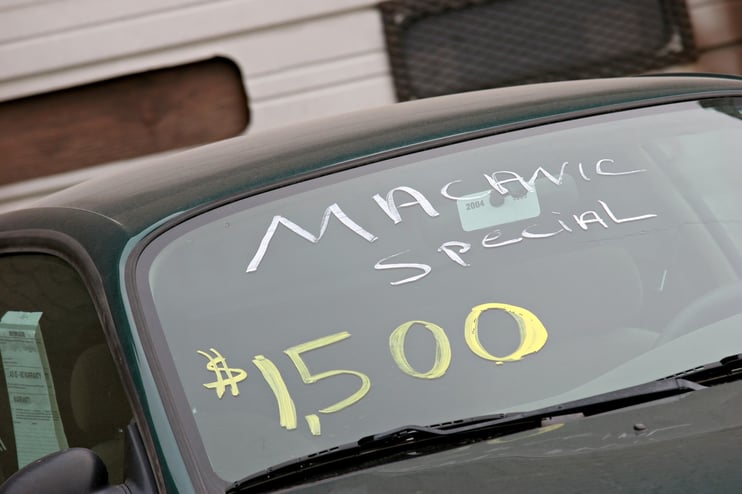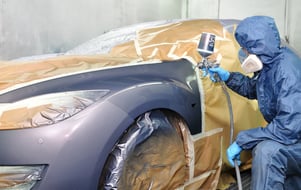 Many American families have two or even three cars, and most people like to drive one they are proud of and admire. But if you are doing a lot of commuting in heavy traffic, you will probably want what people call a “daily driver,” something that can take parking-lot dings and occasional bumps and scrapes that will not worry you very much. You will also want to find a reliable auto repair shop in case things go wrong.
Many American families have two or even three cars, and most people like to drive one they are proud of and admire. But if you are doing a lot of commuting in heavy traffic, you will probably want what people call a “daily driver,” something that can take parking-lot dings and occasional bumps and scrapes that will not worry you very much. You will also want to find a reliable auto repair shop in case things go wrong.
If you live in a part of the country that gets a lot of snow and where the roads are salted in the wintertime, you will want what is called a “beater,” which is a step down from the daily driver.
I went to college in Syracuse, which now gets over a hundred inches of snow a year, thanks to the “lake effect” on Lake Onondaga. The roads are heavily salted and you see the result when you look at parked cars with rust on the quarter panels and around the perimeter of the roof.
Facts to Know Before Buying a Cheap Used Car
There’s a big difference between buying a typical used car and buying a cheap used car. According to a study released by Edmunds in February 2017, the average used car sold for $19,189 in 2016. This was up 3.5 percent from 2015. There are a few reasons why used cars are so expensive:
- 58% of the used cars sold were less than three years old.
- Certified Pre-Owned (CPO) cars were 22.8% of the market. (These cars are almost indistinguishable from new.)
- There was a big influx of cars returned after the expiration of their two- or three-year leases. (Leasing is a big part of the car business today.)
- Banks will loan 100% plus closing costs for a luxury car that is less than 10 years old and has 100,000 miles!
- Banks are offering record low financing rates and terms. (The average interest rate on a used car loan is 7.5% and the average term is 66.8 months.)
- There is great demand for low-mileage SUVs and trucks.
How to Buy a Cheap Used Car
What if you just found out that you need a cheap used car? Perhaps a child is going off to college or a family member just got a job and needs to go to work. Laying out $20,000 is out of the question. What if your budget is only $3,000? What would you do? It seems daunting, but don’t worry, there’s hope!
Obviously, the worst case scenario is to shell out $3,000 for a used car and then have to spend another $3,000 on repairs over the next few months. In this article, we’ll give you some tips on how to approach this project. A car that I recently purchased for $900 with a salvage title (which will remain anonymous for obvious reasons) will serve as an example.
The first place to start is the Internet — search the year, make and model of the car that you are considering. Typically, you will find an owner’s forum, or even an owner’s club, where people who have this car share their experiences. This can be very valuable, although be warned that you may find conflicting information as these are people expressing their personal opinions and most are not trained mechanics.
You will likely find a list of things that typically go wrong with this particular car. Every car, no matter how expensive originally, will have a short list of things that routinely go wrong for the particular model. Using my car as an example, the list said to be aware of the following things that WILL go wrong at some point:
- Crankshaft position sensor
- Turbo
- Water pump
- Fuel pump
- Coolant bypass valve
- Throttle body
- Direct ignition cassette
- Engine mounts
- PCV valve
When I bought the car, the low-oil light illuminated after the car was warmed up. This is probably why the car was in the wrecking yard. However, the problem went away after I changed the oil and filter.
The car also lacked power, so I replaced the ignition cassette and throttle body, and it ran great. Shortly after that, I was on the freeway and noticed a big cloud of blue smoke in the rear view mirror —apparently the turbo finally let go. Well, if you are going to do the turbo, you might as well do the water pump too.
Modern cars are difficult to work on because there is so little room in the engine compartment. Everything is tightly packed and to get one thing out, you have to remove two or three other things to get at it. This means even a simple job will take time, and when you are talking about taking your car to a dealer service department, time is money.
A typical new car dealer will bill out their labor at upwards of $100 an hour. An independent shop probably charges less, but many don’t have access to factory diagnostic software, which means they are guessing what the real problem is.
When my wife’s car broke down, we towed it to the nearest autowerks shop specializing in German cars. The auto repair shop did not have the factory Mercedes software, so the mechanics replaced the crank sensor. However, the real problem was the fuel pump, which had to be replaced a few days later when temperatures warmed up. This was an expensive lesson.
The Reliable Auto Repair Shop
So the first point is to find a trustworthy auto repair shop that specializes in your make and model. You are going to have to ask around, but eventually you will find one. This will become a very important contact for as long as you live in the area and they are still in business. The good news is that once you address the typical items that go wrong, you will probably have a pretty reliable car for the next few years with no depreciation — the biggest expense of car ownership, by the way.
You are probably wondering why I bought this car in the first place. Well, it was a rescue. It was already in the wrecking yard, and was sold as a “builder.” Although I was unfamiliar with this marque, something about it called out to me (well, I am a sucker for station wagons, and I found the styling very appealing). The original MSRP in 2003 was $40,000, so it was a high-quality car. The interior, glass, heated leather seats, carpet, dashboard and headliner were in perfect condition. Most important, the body was almost perfect.
Tips to Save You Time and Money
When you get into car restoration, you will find that restoring the body, paint and interior are a lot more expensive than most mechanical work, so it is unwise to restore a car with body damage or a bad interior. Here in the Bay  Area, a decent paint job will cost upwards of $3,000 by itself. After replacing all the parts you see above, I still had a nasty surprise — the chain tensioner and the starter both failed simultaneously when I was four hours from home. This goes to show that no matter how smart you think you are, a complex mechanical device will always outsmart you.
Area, a decent paint job will cost upwards of $3,000 by itself. After replacing all the parts you see above, I still had a nasty surprise — the chain tensioner and the starter both failed simultaneously when I was four hours from home. This goes to show that no matter how smart you think you are, a complex mechanical device will always outsmart you.
My car is a pretty obscure brand, in fact, it is no longer sold in the US and the dealers are long gone. However, you don’t have to take this risk. If you stick with a mainstream brand and a model which was sold in high numbers, you will always be able to find parts and mechanics who know the car. You will always be able to fit a used engine and drive train for not a lot of money. Even if you spend $3,000 for the car and another $2,000 in parts and labor over the next four years, you will come out way ahead of someone who is spending and financing a $20,000 purchase.
Other Ways to Save Time and Money
CrossCheck is ready to help you when that unexpected repair comes due. When the auto repair shop gives you an estimate for a $1,000 repair, the CrossCheck Multiple Check program is a win-win for everyone.
CrossCheck allows you to write up to four checks to be deposited up to 30 days in the future without applying for credit or paying interest. This gives you peace of mind that you can get the work done and have the car ready for work, and it allows the merchant to make a sale that they would not otherwise make.
The repair shop pays us a small fee — typically less than they would to accept a credit card — and we guarantee these payments and even do the banking for them. This is why so many car dealers, auto aftermarket, and repair shops use CrossCheck — we provide an indispensable product to help them help their customers, so you can keep coming back, but hopefully not too often. Repair shops can download our free guide about Multiple Check to learn more.



